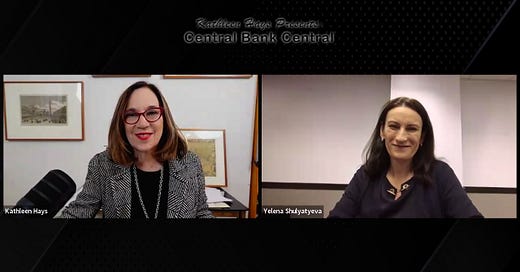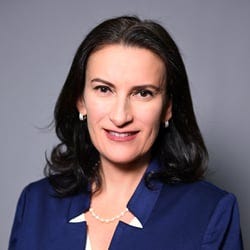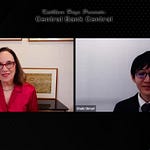Yelena Shulyatyeva is certain that one powerful dynamic is casting a shadow over the U.S. economy even as so many recent indicators show it’s still chugging along. She notes that the labor market remains on solid ground, consumers are still spending albeit at a recent slower pace, and business confidence - which should bolster investment - is jumping. In fact the Conference Board’s CEO Confidence Index jumped to hit its highest level in three years in the first quarter of the year.
So what’s got the Conference Board’s Senior U.S. economist worried? Uncertainty.
”So… businesses are optimistic about the outlook,” Yelena says. “They are optimistic about those deregulation themes and they are optimistic about tax policy. But there's a lot of uncertainty in the economy, and we do monitor those indexes of uncertainty from different surveys.
“They have increased significantly. And this is something that I think would weigh on economic growth going forward.”
Yelena says this in turn will allow inflation to resume its steady if slow downward trend which will open the door to Fed rate cuts, starting as early as July.
So dive in and hear what she has to say. Important to note that Yelena said she sees the direction of inflation expectations being key to how the Fed’s monetary policy path evolves this year as top Fed officials say they still see them well anchored.
Conference Board’s CEO Survey jumps 00:01:17:04 - 00:01:45:04
<the Conference Board CEO Survey reading> was a broad-based increase in confidence among businesses: a 9 point increase. And this is significantly above the breakeven level. So companies are feeling confident and they're feeling confident about the outlook. What does it mean?
Early-in-the-year CEO optimism 00:01:45:04 - 00:02:13:24
And the survey was taken from the end of January through the 10th of February. So there were a lot of different developments during that time. But one thing I think is really driving confidence among those CEOs is that they expecting less regulation, they are expecting favorable changes on the tech front. So these are the key themes for those folks.
CEO Confidence was derailed by Tariffs in the first Trump go-round 00:02:13:24 - 00:03:25:13
I looked back at the survey back to the first Trump administration, so it was relatively high when the president came into power. But when the tariffs were announced and then consequently, there were some you know, some of them imposed, we saw quite a significant decline in that confidence. So I'm cautiously optimistic about the outlook, and this is a great result, but we'll see how it goes on and how it develops as the year progresses.
FOMC members: cautiously optimistic but uncertain 00:03:46:09 - 00:04:17:03
So I would also say that the same kind of theme was reflected in the minutes that were released on Wednesday. So, again, businesses are optimistic about the outlook. They are optimistic about those deregulation themes and they are optimistic about tax policy. But there's a lot of uncertainty in the economy, and we do monitor those indexes of uncertainty from different surveys.
Business uncertainty measures 00:04:36:16 - 00:05:04:15
There's a small business uncertainty index. There's the one that is also broadly based trade uncertainty and tariff uncertainty index news-based uncertainty index as well. So these are the things that we look at all the time.
Rate cuts ahead despite ‘sticky’ inflation 00:05:29:04 - 00:06:19:13
Well, our projection is for three rate cuts in the second half of the year. But that's the key point. So we do see them being very patient in the first half of the year. And yes, uncertainty plays a significant role. Obviously, sticky inflation is something that everybody is watching because of this residual seasonality issue. Right. So as we know, last year was a great example. Inflation got very sticky in the beginning of the year. And after that, it kind of like we did see a lot of progress in the second half of the year.
Fed in a good spot with early-in-the-year inflation distortion 00:06:19:15 - 00:06:45:10
Actually, Governor Waller in his recent speech mentioned that impact and he said two thirds of the time. The recent said research shows that inflation in the first half of the year was higher than in the second half. So that tells you there's something in there. So why not? The Fed is in a very good spot right now to be patient and wait and wait how it plays out.
Labor market enables Fed flexibility-00:06:45:16 - 00:07:07:00
So another thing that I would mention is that the state of the labor market is really letting them do that right now. So, you know, the labor market is in a very good spot. So but it could it's kind of a Goldilocks scenario, right now, but it could evolve either to the upside or to the downside, and we don't know where to go.
Lots of uncertainty a good time to wait 00:07:07:02 - 00:08:13:03
So, again, I would like to stress the impact of uncertainty are companies that are feeling really well right now and feeling very optimistic about the outlook. Are they going to spend, expand the labor force and how are they going to find all these people, given that the recent developments in immigration? On the other hand, I think if the consumer pulls back a little bit and, you know, I wouldn't say the latest retail sales report was like something that we are going to see going forward this year. It was a significant decline in January. I think… at least some slowdown in consumer spending probably is something that we should expect. And given that backdrop, I don't think we will see significant acceleration in the labor market. So I think now is a good point in time to wait. But I think things will develop more quickly as the year progresses.
Inflation expectations will be in the spot-light 00:10:06:22 - 00:11:06:02
Well, you brought up a very interesting topic about inflation expectations. And I think this is going to be very key to how the policy evolves in the coming months or quarters. So you mentioned the University of Michigan survey, the Conference Board has its own survey and obviously there's a very well-respected survey from the New York Fed. So we'll see how this evolves over the in the coming months. But I think that's going to be the inflation expectations story will be the key determinant of what the Fed will do going forward, because, you know, we are not. So this tariffs here. Right. And that is probably, you know, causing some pickup in those inflation expectations. And, you know, it's pretty safe to assume that.
Dual mandate dueling risks 00:11:06:02 - 00:12:07:18
How do <consumers> see that, you know, inflation, prices going higher in the coming months? Will that affect their spending decisions? That's a really key question. So on the one hand, you have this inflation being sticky and potentially inflation expectations going higher. But on the other hand, you have significant downside risks to growth and the Fed will equally look at these things, you know, in terms of how they impacts the labor market. So I think it's a very tricky situation for the Fed this year for sure, because there will be like a conflict between the dual mandate targets. No, way, no matter how you look at it and, you know, at the end of the day, we think that expectations for growth for the labor market will prevail. And I think what I would like to stress is that we do expect some slowdown in economic growth.
No downturn Conference board view on inflation expectations is more muted 00:12:07:23 - 00:13:27:17
We're not expecting a downturn of any sort, obviously. But I think the gradual moderation in growth will continue. And, you know, the Fed will be very attentive to that before we move on inflation expectations, just tell us a little bit more, because I don't think the model people may not know the Conference Board inflation expectations survey as well as they do something like the University of Michigan, which has been going on for decades and decades and decades. When we turn to the Conference Board, inflation expectations look more contained, but we will get a new number next week. So we'll see how that looks like in terms of, you know, and those things could be affected by many different things, not necessarily, tariffs, for example, it could be affected by price of eggs, which surged quite significantly, as we know, and also gasoline price fluctuations. <in contrast> the New York Fed survey indicated that was more like a flat line.
Manufacturing survey is strong CapEx plans are not 00:14:01:04 - 00:15:23:15
It's one watch closely in markets. There's a lot of these manufacturing indexes, business indexes, but this is one I think people it's one of the first ones. And people keep their eye on it. And of course, with manufacturing, people wonder what's going to happen there. And the president, of course, a lot of his tariff, his tariffs plan is to help bring back U.S. manufacturing I was looking under the hood and what I found very interesting is quite a significant decline in CapEx intentions. So another so companies are not planning to invest as much as they did back in the day. So is it reflecting that uncertainty that I mentioned earlier? Is it something, you know, they're just postponing the investment plans? Another survey, the Empire State Survey, also showed a decline in CapEx intentions that was released earlier this week.
Signals at a cross roads flashing mixed crossed results 00:15:23:17 - 00:15:47:15
So that kind of contradicts what we see in our own survey. So there are a lot of different signals. And I think it's not surprising, actually, because there are a lot of different signals on the policy front. On the one hand, you have like very positive business friendly signals coming from deregulation, tax policy, potential changes in tax policy.
Tariffs: the elephant in the room 00:15:47:17 - 00:16:23:16
But at the same time, tariffs is a really big elephant in the room. So how much, when, what, which countries, which products it will affect if they're implemented? That's that's a big, big question. And I think, you know, until we know what's what's going on with that policy lever, I think we will see some uncertainty and potentially a pullback in investment plans, which, by the way, would also entail some pulling back on hiring plans if it continues.
Outlook 2025 2026 00:21:07:23 - 00:22:19:13
I think we will continue to see some moderation of economic growth towards the end of the year. We expect growth to slow down to something around the potential over the turn of the year. I think just because, you know, we have seen a lot of strengths earlier last year and over the turn of this year in consumer spending and in 2024 in terms of business spending, I think some of it at least partially, was borrowing some strengths from this year ahead of potential tariffs. Companies and consumers alike, they hear all this news and they probably, you know, decided to stock up ahead of those potential tariffs. So that's why we saw such strong numbers in business investment earlier in 2024. And among consumers, you know, over the turn of the year, I think we will probably see that unwinding a little bit as the year progresses.
Labor market is still solid but with softer growth 00:22:19:15 - 00:22:48:01
And also just because, the labor market has come down quite significantly, it's not weak, it's still very healthy. But at the same time, the growth rate has come down. And with that, we will see some moderation in disposable personal income growth, which in turn should weigh slightly on the pace of consumption. So not nothing really dramatic.
Looking for three cuts…maybe 00:22:48:03 - 00:23:18:00
And, there's always a risk something dramatic will happen. But in our forecast, we see moderation. And with that, some moderation in inflation as well. And you still see what, three rate cuts this year starting sometime mid-summer. And that's right. That's our baseline. But, there are risks to both sides. So if we see inflation remain sticky for longer, that could obviously reduce the number of cuts.
--
Yelena Shulyatyeva
Senior US Economist
The Conference Board
Yelena Shulyatyeva is a Senior US Economist for The Conference Board Economy, Strategy & Finance Center, where she focuses on analyzing macroeconomic developments in order to better understand the implications for the broader economy and monetary policy. As part of a team of economists, she produces in-depth analysis of macroeconomic data and trends for the community of C-suite executives providing the insights to help companies make effective strategic decisions to accelerate growth.
Yelena brings twenty years of experience as a U.S. economist at BNP Paribas and Bloomberg L.P. where she provided clients with forecasts and analysis of macroeconomic and financial developments. She regularly appears on business television & radio, and is frequently quoted in media.
Yelena is a member of the Board of Directors of Money Marketeers of NYU and the New York Association for Business Economics (NYABE).
Yelena holds a CFA designation as well as Masters Degrees in Finance & Investments and Economics.
Publications by Yelena Shulyatyeva
Articles
Global Forecast Update 13 February, 2025
The Conference Board Economic Forecast for the US Economy 12 February, 2025














Share this post